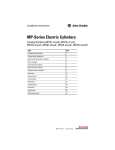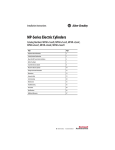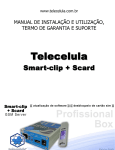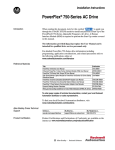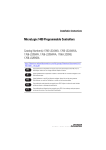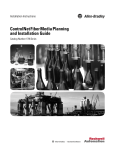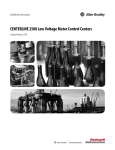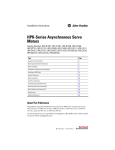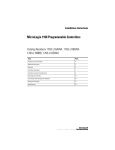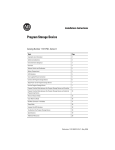Download TLAR-IN001 - Rockwell Automation
Transcript
Installation Instructions TL-Series Electric Cylinders Catalog Numbers TLAR-A1xxxB, TLAR-A1xxxE, TLAR-A2xxxC, TLAR-A2xxxF, TLAR-A3xxxE, TLAR-A3xxxH Topic Page Catalog Number Explanation 3 About the TL-Series Electric Cylinders 4 Before You Begin 5 Install the Electric Cylinder 7 Mount the Electric Cylinder 10 Dimensions 11 Connector Data 15 Commissioning 16 Maintenance 29 Storage 30 Troubleshooting 30 Accessories 32 Interconnect Diagrams 36 Additional Resources 40 2 TL-Series Electric Cylinders Important User Information Read this document and the documents listed in the additional resources section about installation, configuration, and operation of this equipment before you install, configure, operate, or maintain this product. Users are required to familiarize themselves with installation and wiring instructions in addition to requirements of all applicable codes, laws, and standards. Activities including installation, adjustments, putting into service, use, assembly, disassembly, and maintenance are required to be carried out by suitably trained personnel in accordance with applicable code of practice. If this equipment is used in a manner not specified by the manufacturer, the protection provided by the equipment may be impaired. In no event will Rockwell Automation, Inc. be responsible or liable for indirect or consequential damages resulting from the use or application of this equipment. The examples and diagrams in this manual are included solely for illustrative purposes. Because of the many variables and requirements associated with any particular installation, Rockwell Automation, Inc. cannot assume responsibility or liability for actual use based on the examples and diagrams. No patent liability is assumed by Rockwell Automation, Inc. with respect to use of information, circuits, equipment, or software described in this manual. Reproduction of the contents of this manual, in whole or in part, without written permission of Rockwell Automation, Inc., is prohibited. Throughout this manual, when necessary, we use notes to make you aware of safety considerations. WARNING: Identifies information about practices or circumstances that can cause an explosion in a hazardous environment, which may lead to personal injury or death, property damage, or economic loss. ATTENTION: Identifies information about practices or circumstances that can lead to personal injury or death, property damage, or economic loss. Attentions help you identify a hazard, avoid a hazard, and recognize the consequence. IMPORTANT Identifies information that is critical for successful application and understanding of the product. Labels may also be on or inside the equipment to provide specific precautions. SHOCK HAZARD: Labels may be on or inside the equipment, for example, a drive or motor, to alert people that dangerous voltage may be present. BURN HAZARD: Labels may be on or inside the equipment, for example, a drive or motor, to alert people that surfaces may reach dangerous temperatures. ARC FLASH HAZARD: Labels may be on or inside the equipment, for example, a motor control center, to alert people to potential Arc Flash. Arc Flash will cause severe injury or death. Wear proper Personal Protective Equipment (PPE). Follow ALL Regulatory requirements for safe work practices and for Personal Protective Equipment (PPE). Rockwell Automation Publication TLAR-IN001C-EN-P - September 2015 TL-Series Electric Cylinders 3 Catalog Number Explanation Catalog numbers consist of various characters, each identifies a specific version or option for that component. Use the catalog numbering chart below to understand the configuration of your actuator. TL AR - xx xxx x - x x A Motor Mounting (1) A = Axial (in-line) Holding Brake (1) 2 = No Brake 4 = 24V DC Brake Feedback (1) B = Multi-turn, absolute 17-bit encoder, battery backed Mechanical Drive/Screw Lead, Motor Type B = 3.0 mm/rev (0.118 in./rev) C = 5.0 mm/rev (0.197 in./rev) E = 10.0 mm/rev (0.394 in./rev) F = 12.7 mm/rev (0.50 in./rev) H = 20.0 mm/rev (0.787 in./rev) Rod Stroke Length 100 = 100 mm (3.94 in.) 200 = 200 mm (7.87 in.) 300 = 300 mm (11.81 in.) 400 = 400 mm (15.75 in.) 600 = 600 mm (23.62 in.) 800 = 800 mm (31.50 in.) Actuator Frame Size 1 = 32 2 = 40 3 = 63 Voltage Class/Designator A = 230V motors X = Actuator cylinder replacement part (refer to Actuator Cylinders on page 35 for ordering examples) Actuator Type AR = Actuator Rod Bulletin Number TL-Series™ (1) This field does not apply to actuator cylinder replacement parts. MP AR - xx xxxxxx Accessory Item Number Accessory Type NA = Axial (in-line) Mounting Accessory NP = Parallel Mounting Accessory NE = Rod-end Accessory Actuator Type AR = Actuator Rod Bulletin Number MP = MP-Series™ or TL-Series Actuator Accessory Rockwell Automation Publication TLAR-IN001C-EN-P - September 2015 4 TL-Series Electric Cylinders About the TL-Series Electric Cylinders TL-Series electric cylinders feature multi-turn high-resolution encoders and are available with 24V DC brakes. The TL-Series motor rotates a ball screw drive that converts rotary motion into linear movement. This linear movement results in the piston rod extending and retracting from the electric cylinder housing. IMPORTANT The TLAR-Axxxxx-x2A electric cylinders are non-braking. When there is no input torque, the piston rod can be moved freely. You can achieve self-locking of your motion system by using motors with an integrated brake or with high self-braking torque. The TL-Series electric cylinders have been designed for exact positioning at high speeds. 1 2 3 4 (x4) 5 6 7 (x4) 8 9 Item Description 1 Power connector 2 Feedback connector 3 TL-Series motor 4 Motor mounting bolts 5 Actuator cylinder 6 Breather port (must not be sealed or covered) 7 Hollow bolts with internal treads for fastening 8 Piston rod 9 Wrench flats for counteracting torque on piston rod Rockwell Automation Publication TLAR-IN001C-EN-P - September 2015 TL-Series Electric Cylinders 5 Before You Begin Remove all packing material, wedges, and braces from within and around the item. After unpacking, verify the nameplate catalog number against the purchase order. 1. Remove packaging polyethylene foil and cardboard. The packing materials are recyclable, except for oiled paper that is waste. 2. Remove the electric cylinder carefully from its shipping container. Consider the weight of the electric cylinder. Depending on the design, the electric cylinder can weigh up to 15.0 kg (33.07 lb). 3. Visually inspect the electric cylinder for damage. 4. Examine the electric cylinder frame, piston shaft, and hollow bolts for anomalies. 5. Notify the carrier of shipping damage immediately. ATTENTION: Do not attempt to open and modify the electric cylinder. Only a qualified Allen-Bradley employee can service the internal working of the electric cylinder or motor. Failure to observe these safety precautions could result in personal injury or damage to equipment. Planning Your Installation See Kinetix Linear Motion Specifications, publication GMC-TD002, for the specifications and more products that are referenced in this section: • This product can be operated in compliance with the relevant safety regulations, only if the maximum loading limits are observed. ATTENTION: The electric-cylinder is not intended to be used in applications where side-loading occurs. Loads must be guided and supported. Align the load with the line-of-motion of the piston rod. Side loading reduces the lifetime of the electric-cylinder. • If you are mounting your electric cylinder in a vertical or sloping position, include safety measures that control the work load, if the spindle nut fails. ATTENTION: Uncontrolled moving masses can injure or damage to property. If there is a spindle nut fracture inside the electric cylinder due to wear, the working mass drops down. Check whether more external safety measures are required to prevent damage in the event of a spindle nut fracture. • Corrosive environments reduce the service life of electric cylinders. • Depending on the work load, the piston rod can bend. See the piston-rod deflection specifications for limitations. • Motor feedback, auxiliary feedback, and I/O connector kits are not included, but can be purchased separately. Rockwell Automation Publication TLAR-IN001C-EN-P - September 2015 6 TL-Series Electric Cylinders • Factory manufactured feedback and power cables are available in standard cable lengths. They provide environmental sealing and shield termination. Contact your Rockwell Automation sales office or refer to the selection guide for cables. Electric Cylinders with Brake Option The brake option on this servo motor is a spring-set holding brake that releases when voltage is applied to the brake coil. A separate power source is required to disengage the brake. The servo motor controller can apply the power source or it can be done manual operator control. If system main power fails, holding brakes can withstand occasional use as stopping brakes. However, it creates rotational mechanical backlash that is potentially damaging to the system, increases brake wear, and reduces brake life. An unpowered electric cylinder requires a brake to maintain its position if the force on the actuator exceeds the Back Drive Force that is listed in Kinetix® Linear Motion Specifications Technical Data, publication GMC-TD002. A brake can be use with the actuator to keep it from back driving, typically in vertical applications. A brake can be used for safety reasons or for energy savings, allowing the actuator to hold position when unpowered. IMPORTANT Holding brakes are not designed to stop rotation of the motor shaft, nor are they intended to be used as a safety device. They are designed to hold a motor shaft at 0 rpm for up to the rated brake holding torque. The recommended method of preventing motor shaft rotation is a four-step process: first, command the servo drive to 0 rpm; second, verify that the motor is at 0 rpm; third, engage the brake; and fourth, disable the drive. Disabling the drive removes the potential for brake wear that is caused by a badly tuned servo system oscillating the shaft. Rockwell Automation Publication TLAR-IN001C-EN-P - September 2015 TL-Series Electric Cylinders 7 Preventing Electrical Noise Electromagnetic interference (EMI), commonly called electrical noise, can reduce motor performance. Effective techniques to counter EMI include filtering the AC power, using shielded cables, separating the signal cables from power wiring, and practicing good grounding techniques. Follow these guidelines to avoid the effects of EMI: • Isolate the power transformers or install line filters on all AC input power lines. • Physically separate signal cables from motor cables and power wiring. Do not route signal cables with motor and power wires, or over the vent openings of servo drives. • Ground all equipment by using a single-point parallel ground system that employs ground bus bars or large straps. If necessary, use more electrical noise reduction techniques to reduce EMI in noisy environments. See System Design for Control of Electrical Noise Reference Manual, publication GMC-RM001, for more information on reducing the effects of EMI. Build and Route Cables Knowledgeable cable routing and careful cable construction improves system electromagnetic compatibility (EMC). Follow these steps to build and install cables. 1. Keep wire lengths as short as physically possible. 2. Route signal cables (encoder, serial, analog) away from motor and power wiring. 3. Separate cables by 0.3 m (1 ft) minimum for every 9 m (30 ft) of parallel run. 4. Ground both ends of the encoder cable shield and twist the signal wire pairs to prevent electromagnetic interference (EMI) from other equipment. ATTENTION: High voltage can be present on the shield of a power cable, if the shield is not grounded. Make sure that there is a connection to ground for any power cable shield. Failure to observe these safety precautions could result in personal injury or damage to equipment. Install the Electric Cylinder The installation must comply with all local regulations and use of equipment and installation practices that promote electromagnetic compatibility and safety. ATTENTION: Unmounted electric cylinders, disconnected mechanical couplings, and disconnected cables are dangerous if power is applied. Appropriately identify disassembled equipment (tagged-out) and access to electrical power restricted (locked-out). Failure to observe these safety precautions could result in personal injury. Rockwell Automation Publication TLAR-IN001C-EN-P - September 2015 8 TL-Series Electric Cylinders ATTENTION: Make sure that cables are installed and restrained to prevent uneven tension or flexion at the cable connectors. Excessive and uneven lateral force at the cable connectors can result in the connector environmental seal opening and closing as the cable flexes. Failure to observe these safety precautions could result in damage to the electric cylinder motor and its components. ATTENTION: Damage can occur to the electric cylinder bearings and the feedback device if a sharp impact to the piston rod is applied during installation. Do not strike the piston rod with tools during installation or removal. Do not attempt to rotate the piston rod. Rotating the piston rod breaks the mechanism that lets the electric cylinder extend and retract. Failure to observe these safety precautions could result in damage to the electric cylinder and its components. Follow these steps to install the electric cylinder. 1. Provide sufficient clearances in the area of the electric cylinder for it to stay within its specified operating temperature range. See Kinetix Linear Motion Specifications Technical Data, publication GMC-TD002, for the operating temperature range. Do not enclose the electric cylinder unless forced air is blown across the electric cylinder for cooling. Keep other heat producing devices away from the electric cylinder. IMPORTANT Position the electric cylinder so that all operating parts are accessible and the breather port is not covered. 2. Make sure that the mounting surface supports the electric cylinder evenly so that it is free of mechanical stress and distortion. The evenness of support surface must be ≤ 0.2 mm (0.008 in.). ATTENTION: Do not modify the settings of the screws and the threaded pins. Do not fasten the electric cylinder by the front cover alone when used with high loads. Heavy tensile strain can cause the screws in the cover to pull out. 3. Attach mounting accessories to the electric cylinder, see Accessories on page 32. Tighten the fastening screws evenly. Attribute Frame 32 Frame 40 Frame 63 Internal thread of cover screws M6 M6 M8 Torque, max (1) 5 N•m (3.69 lb•ft) 5 N•m (3.69 lb•ft) 9 N•m (5.90 lb•ft) (1) Unless otherwise noted, the torque specification has a ±20% tolerance. Rockwell Automation Publication TLAR-IN001C-EN-P - September 2015 TL-Series Electric Cylinders 9 4. Attach rod-end accessories and the work load. Be sure that the work load center of gravity is centric to the piston rod. ATTENTION: Damage can occur to the electric cylinder bearings and the feedback device if sharp impact to the piston rod is applied during installation. Do not strike the piston rod with tools during installation or removal. Failure to observe these safety precautions could result in damage to the electric cylinder and its components. IMPORTANT Do not twist or rotate the piston rod. If the piston rod is rotated, the absolute position of the electric cylinder is lost and the absolute home position must be re-established. When fastening a rod-end accessory or work load to the piston rod, use two wrenches. Use one wrench to tighten the mounting nut or rod-end accessory and the other, on the piston-rod wrench flats, to counter act the applied torque. Be sure that the torque is not applied to the piston rod and that the piston rod does not rotate. Frame Size Piston Rod Thread Wrench Flats Width 32 M10 x 1.25 10 mm 40 M12 x 1.25 13 mm 63 M16 x 1.5 17 mm Wrench Flat ATTENTION: Do not rotate the piston rod during installation. Rotating the piston rod breaks the mechanism that lets the electric cylinder extend and retract. Use two wrenches to install the work load. Failure to observe these safety precautions could result in damage to the electric cylinder and its components. If you are using a coupling piece attachment, catalog number MPAR-NE3612x, or trunnion mounting kit, catalog number MPAR-NA1635xx, see Accessories on page 32 for torque values. If you are using a rod guide accessory, catalog number MPAR-NE34xxx or MPAR-NE150xxx, adjust the guides of the work load and the electric cylinder so that they are exactly parallel. By making the components parallel, you avoid excessive wear on the guide. Rockwell Automation Publication TLAR-IN001C-EN-P - September 2015 10 TL-Series Electric Cylinders Mount the Electric Cylinder 1. Use stainless steel fasteners to mount your electric cylinder to your application. 2. Attach power and feedback cables and use a drip loop in the cable to keep liquids away from the motor. Power Connector Feedback Connector Drip Loop BURN HAZARD: Outer surfaces of the motor can reach high temperatures, 65 °C (149 °F), during electric cylinder operation. Take precautions to prevent accidental contact with hot surfaces. Failure to observe these safety precautions can result in personal injury. ATTENTION: Consider electric-cylinder surface temperature when selecting motor-mating connections and cables. Failure to observe these safety precautions can result in personal injury or damage to equipment. ATTENTION: Keyed connectors must be properly aligned and hand-tightened the recommended number of turns. Improper connector alignment requires excessive force, such as the need for t tools to fully seat connectors. Failure to observe these safety precautions could result in damage to the motor and cable, and their components. ATTENTION: Be sure that cables are installed and restrained to prevent uneven tension or flexion at the cable connectors. Excessive and uneven force at the cable connector can result in damage to the housing and contacts as the cable flexes. Failure to observe these safety precautions can result in damage to the motor and its components. Rockwell Automation Publication TLAR-IN001C-EN-P - September 2015 TG Ø30.0 (1.18) d11 Ø16.0 (0.63) h9 12 Flat for Wrench Power/Brake Connector 6.0 (0.24) (x4) E TG E M10x1.25 AM Feedback Connector M6 (x4) 10 L1 See Detail A TL-Series Electric Cylinders (frame 32 and frame 40) Dimensions G ZJ+ L2+ L7 GI Ø16.0 (0.63) Detail A Frame 32 Ø35.0 (1.38) d11 Ø20.0 (0.79) h9 LB + = Plus Stroke Length 16.0 (0.63) M12x1.25 Dimensions ZJ, and L7 are with piston rod is fully retracted. VD WH 1000 (39.4) ±50 (1.97) Dimensions are in mm (in.) 13 Ø16.0 (0.63) P HD Detail A Frame 40 AD TL-Series Electric Cylinders 11 Rockwell Automation Publication TLAR-IN001C-EN-P - September 2015 12 TL-Series Electric Cylinders TL-Series Electric Cylinder Dimensions (frame 32) Electric Cylinder Cat. No. L7 (1) mm (in.) LB (1) P AD HD AM G1 L1 ZJ (2) WH mm (in.) mm (in.) mm (in.) mm (in.) mm (in.) mm (in.) mm (in.) mm (in.) mm (in.) TLAR-A1100B-B2A 391.5 (15.41) TLAR-A1200B-B2A 491.5 (19.35) 73.5 (2.89) TLAR-A1300B-B2A 591.5 (23.29) TLAR-A1400B-B2A 691.5 (27.22) TLAR-A1100E-B2A 405.5 (15.96) TLAR-A1200E-B2A 505.5 (19.90) TLAR-A1300E-B2A 605.5 (23.84) TLAR-A1400E-B2A 705.5 (27.78) (1) (2) 76.1 (3.0) 109.1 (4.30) 110.7 (4.36) 40.0 (1.57) 31.1 (1.22) 51.1 (2.01) 22.0 (0.87) 60.0 (2.36) 43.0 (1.69) 26.0 (1.02) 18.0 (0.71) 148.0 (5.83) 26.0 (1.02) 73.0 (2.87) If ordering TLAR-A1xxxB-B4A actuator with brake, add 35.6 mm (1.40 in.) to dimensions L7 and LB. If ordering TLAR-A2xxxE-B4A actuator with brake, add 34.6 mm (1.36 in.) to dimensions L7 and LB. The tolerance for this dimension is ±1.0 mm (0.039 in.). TL-Series Electric Cylinder Dimensions (frame 40) Electric Cylinder Cat. No. L7 (1) mm (in.) TLAR-A2100C-B2A 436.0 (17.17) TLAR-A2200C-B2A 536.0 (21.10) TLAR-A2300C-B2A 636.0 (25.04) TLAR-A2400C-B2A 736.0 (28.98) TLAR-A2600C-B2A 936.0 (36.85) TLAR-A2100F-B2A 457.9 (18.03) TLAR-A2200F-B2A 557.9 (21.96) TLAR-A2300F-B2A 657.9 (25.90) TLAR-A2400F-B2A 757.9 (29.84) TLAR-A2600F-B2A 957.9 (37.71) (1) (2) LB (1) P AD HD AM G1 L1 ZJ (2) WH mm (in.) mm (in.) mm (in.) mm (in.) mm (in.) mm (in.) mm (in.) mm (in.) mm (in.) 76.1 (3.0) 60.0 (2.36) 43.0 (1.69) 73.0 (2.87) 24.0 (0.94) 30.0 (1.18) 21.5 (0.85) 176.5 (6.95) 30.0 (1.18) 98.1 (3.86) If ordering TLAR-A2xxxx-B4A actuator with brake, add 36.1 mm (1.42 in.) to dimensions L7 and LB. The tolerance for this dimension is ±1.0 mm (0.039 in.). Actuators are designed to metric dimensions. Inch dimensions are approximate conversions from millimeters. Dimensions without tolerances are for reference. Rockwell Automation Publication TLAR-IN001C-EN-P - September 2015 8.0 (0.31) (x4) E Rockwell Automation Publication TLAR-IN001C-EN-P - September 2015 Flat for Wrench Power/Brake Connector TG TG E AM Feedback Connector M8 (x4) L1 See Detail A TL-Series Electric Cylinders (frame 63) G ZJ+ L2+ L7 + = Plus Stroke Length GI Ø45.0 (1.77) d11 Ø28.0 (1.10) h9 20.0 (0.79) Dimensions ZJ, and L7 are with piston rod is fully retracted. VD WH M16x1.50 1000 (39.4) ±50 (1.97) LB 17 Dimensions are in mm (in.) Detail A Frame 63 P Ø17.0 (0.67) AD HD 13 TL-Series Electric Cylinders 14 TL-Series Electric Cylinders TL-Series Electric Cylinder Dimensions (frame 63) Electric Cylinder Cat. No. L7 (1) mm (in.) TLAR-A3100E-B2A 564.6 (22.23) TLAR-A3200E-B2A 664.6 (26.17) TLAR-A3300E-B2A 764.6 (30.10) TLAR-A3400E-B2A 864.6 (34.04) TLAR-A3600E-B2A 1064.6 (41.91) TLAR-A3800E-B2A 1264.6 (49.79) TLAR-A3100H-B2A 564.6 (22.23) TLAR-A3200H-B2A 664.6 (26.17) TLAR-A3300H-B2A 764.6 (30.10) TLAR-A3400H-B2A 864.6 (34.04) TLAR-A3600H-B2A 1064.6 (41.91) TLAR-A3800H-B2A 1264.6 (49.79) (1) (2) LB (1) P AD HD AM G1 L1 ZJ (2) mm (in.) mm (in.) mm (in.) mm (in.) mm (in.) mm (in.) mm (in.) mm (in.) WH mm (in.) 144.2 (5.68) 37.0 (1.46) 86.0 (3.39) 56.0 (2.20) 99.0 (3.90) 32.0 (1.26) 36.0 (1.42) 28.5 (1.12) 214.0 (8.43) If ordering TLAR-A3xxxx-B4A actuator with brake, add 23.0 mm (0.91 in.) to dimensions L7 and LB. The tolerance for this dimension is ±1.0 mm (0.039 in.). Actuators are designed to metric dimensions. Inch dimensions are approximate conversions from millimeters. Dimensions without tolerances are for reference. Rockwell Automation Publication TLAR-IN001C-EN-P - September 2015 TL-Series Electric Cylinders 15 Connector Data This table lists the signal descriptions for feedback, power, and brake connector pins on the electric cylinder. Feedback Pin Signal Tyco AMP 206152-1 1…5 Reserved — 6 BAT+ Brown 7…12 Reserved — 13 Data+ Blue 14 Data- Blue/black 15…21 Reserved — 22 EPWR 5V Red 23 ECOM & BAT- Black 24 Shield Drain wire 25…28 Reserved — 1 4 9 15 21 26 3 8 14 20 25 28 Power and Brake Pin Signal Tyco AMP 206705-2 1 U phase Red 2 V phase White 3 W phase Black 4 Reserved — 5 Ground Yellow/green and drain wires 6 Reserved — 7 MBRK+ Yellow 8 Reserved — 9 MBRK- Blue 1 3 4 6 7 9 ATTENTION: Be sure that cables are installed and restrained to prevent uneven tension or flexion at the cable connectors. Excessive and uneven force at the cable connector can result in damage to the housing and contacts as the cable flexes. Failure to observe these safety precautions could result in damage to the motor and its components. Rockwell Automation Publication TLAR-IN001C-EN-P - September 2015 16 TL-Series Electric Cylinders Commissioning This section provides guidelines for using the Studio 5000 Logix Designer™ application to configure your electric cylinder servo-drive system. Required Files Firmware revisions and software versions that are required to support the electric cylinders include the following: • Kinetix 2000 multi-axis drives – Firmware revision 1.096 or later – Studio 5000 Logix Designer application – For RSLogix 5000® software, version 16.xx, Use Motion Database file, version 4_18_0 or later – For RSLogix 5000 software, version 17.xx or later, Use Motion Database file, version 5_9_0 or later • Kinetix 3 component servo drive – Connected Components Workbench™ software • Kinetix 350 single-axis EtherNet/IP servo drive – Logix Designer application • Kinetix 300 EtherNet/IP Indexing Servo Drive – Logix Designer application • Motion Analyzer software, version 4.70 or later Download these files from http://www.rockwellautomation.com/support. Configure Your Electric Cylinder Configure the electric cylinder by using the basic parameter settings that are described in this section. Use the procedure appropriate for your drive. ATTENTION: Moving parts can cause injuries. Before running the electric cylinder, make sure that all components are secure and safe guards are in place to prevent access to the path of moving machinery. Safeguards must prevent access to the electric cylinder until all motion has stopped. Check that the electric cylinder is clear of foreign matter and tools. Objects hit by the moving piston rod can become projectiles that cause personnel injury or damage to the equipment. IMPORTANT You are responsible to verify that the servo control system safely controls the electric cylinder regarding maximum force, acceleration, and speed. Rockwell Automation Publication TLAR-IN001C-EN-P - September 2015 TL-Series Electric Cylinders 17 Configure the Logix Designer Application for Electric Cylinder with Kinetix Drives Use the following procedure to configure the drive for your electric cylinder. It is assumed that the electric cylinder and a Kinetix 2000 or Kinetix 350 drive are installed and wired. ATTENTION: Incorrect parameter settings can result in uncontrolled motion, with the potential for damage to the electric cylinder. Initiating a motion command on an electric cylinder with an incorrect Position mode setting can result in damage to the electric cylinder, and the machine in which it is installed. 1. Open the Logix Designer application. 2. On the Axis Properties tabs, enter these parameters for your electric cylinder. Axis Properties Tab Drive/Motor Parameter Entry/Selection Motor Catalog Number Select one from this list TLAR -A1xxxB-B2A TLAR -A1xxxB-B4A TLAR -A1xxxE-B2A TLAR -A1xxxE-B4A TLAR -A2xxxC-B2A TLAR -A2xxxC-B4A TLAR -A2xxxF-B2A TLAR -A2xxxF-B4A TLAR -A3xxxE-B2A TLAR -A3xxxE-B4A TLAR -A3xxxH-B2A TLAR -A3xxxH-B4A Drive Resolution 200,000 Drive Counts per Motor Rev Rockwell Automation Publication TLAR-IN001C-EN-P - September 2015 18 TL-Series Electric Cylinders Entry/Selection, with applicable distance unit settings Axis Properties Tab Parameter Conversion Positioning Mode Metric English Linear Setting the Positioning Mode to Rotary can damage to the electric cylinder or the machine due to incorrect positioning. Conversion Constant 66666.667 drive cnts/1.0 mm for 1693333.3 drive cnts/1.0 in. for TLAR-x1xxxB-B2A TLAR-x1xxxB-B4A Conversion Constant 20000 drive cnts/1.0 mm for 508000 drive cnts/1.0 in. for TLAR-x1xxxE-B2A TLAR-x1xxxE-B4A TLAR-x3xxxE-B2A TLAR-x3xxxE-B4A Conversion Constant 40000 drive cnts/1.0 mm for 1016000 drive cnts/1.0 in. for TLAR-x2xxxC-B2A TLAR-x2xxxC-B4A Conversion Constant 15748.0315 drive cnts/1.0 mm for 400000 drive cnts/1.0 in. for TLAR-x2xxxF-B2A TLAR-x2xxxF-B4A Conversion Constant 10000 drive cnts/1.0 mm for 254000 drive cnts/1.0 in. for TLAR-x3xxxH-B2A TLAR-x3xxxH-B4A Dynamics Maximum Speed(1) 150 mm/s (default 157.5 mm/s) 5.91 in/s (default 6.20 in/s) TLAR-x1xxxB-xxA 500 mm/s (default 525 mm/s) 19.68 in/s (default 20.67 in/s) TLAR-x1xxxE-xxA TLAR-x3xxxE-xxA 250 mm/s (default 262.5 mm/s) 9.82 in/s (default 10.33 in/s) TLAR-x2xxxC-xxA 640 mm/s (default 672 mm/s) 24.61 in/s (default 25.84 in/s) TLAR-x2xxxF-xxA 1000 mm/s (default 1050 mm/s) 41.34 in/s (default 43.41 in/s) TLARx3xxxH-xxA Maximum Acceleration (2) 6000 mm/s/s 236.22 in/s/s Maximum Deceleration (2) 6000 mm/s/s 236.22 in/s/s Maximum Acceleration Jerk Use default values, or adjust for your application. Maximum Deceleration Jerk Use default values, or adjust for your application. (1) The default value is 5% more than your actuator rated maximum speed. Do not command maximum speed in your application in excess of the rated speed. (2) Accelerations in excess of the following can lead to reduction of life of your actuator. Rockwell Automation Publication TLAR-IN001C-EN-P - September 2015 TL-Series Electric Cylinders 19 3. Click the Homing tab. 4. Set parameters for either absolute homing or torque level-to-marker homing as shown in the table. Parameter Absolute Homing Torque Level-to-Marker Homing Value Value Mode Absolute Active Position 0, typical 0, typical Offset N/A 0 mm Sequence Immediate Torque Level-to-Marker Direction N/A Reverse Bi-directional Torque Level N/A 30%, min Greater if the system friction, force, or weight exceeds 30% of the Continuous Force Rating at any point in the range of motion Speed N/A 10 mm/s (1.97 in/s) Return Speed N/A 10 mm/s (0.39 in/s) ATTENTION: Avoid excessive force while homing the electric cylinder. Do not exceed 10 mm/s (0.4 in/s) during a home routine. Speeds greater than 10 mm/s (0.4 in/s) can damage the electric cylinder when the piston rod reaches the end of travel. 5. Do the following for absolute homing. a. Use motion direct commands to jog your axis slowly to the home location; do not exceed 10 mm/s (0.4 in/s). a. Issue the Motion Direct Command (MAH) to set the home position on your axis. 6. Click the Limits tab. 7. Enter these parameters. Parameter Entry/Selection, with Applicable Distance Unit Settings Hard Travel Limits Check if hardware limits are in use. Use the Motion Analyzer software to determine the maximum stopping distance in your application to set negative and positive limits. Soft Travel Limits Check if software limits are in use. Use the Motion Analyzer software to determine the maximum stopping distance in your application to set negative and positive limits. Maximum Positive Enter a value that is within the piston-rod mechanical travel. Maximum Negative Enter a value that is within the piston-rod mechanical travel. Rockwell Automation Publication TLAR-IN001C-EN-P - September 2015 20 TL-Series Electric Cylinders 8. Set overtravel limits according to the maximum speed of the servo drive system and the payload of the application. ATTENTION: Software overtravel must be set before you initiate the tuning process. Check the starting position of the piston rod and allow for adequate travel. Insufficient travel while auto tuning causes the software overtravel to trigger or an end-stop impact. IMPORTANT Set travel limits and direction of tuning moves in reference to the piston rod starting position. Leave adequate travel for the piston rod to complete its moves while tuning. You can determine the deceleration distance before the piston rod contacts the end of travel that is based on the deceleration rate of the load, and the available peak force from the motor/ballscrew combination. Use the Motion Analyzer software to calculate the minimum deceleration distance at the maximum speed of your application. IMPORTANT Do not exceed the maximum energy that is specified for end-of-travel impacts. Impact Energy Cat. No. Impact Energy, max TLAR-x1xxxx-xxA 0.0001 J TLAR-x2xxxx-xxA 0.0002 J TLAR-x3xxxx-xxA 0.0004 J This table lists maximum velocity for end-stop impact with no load. End-stop Impact Cat. No. Extracted Mass g (oz) Impact Velocity, max mm/s (in/s) TLAR-x1100B-xxx 239 (8.4) 28.9 (1.14) TLAR-x1200B-xxx 308 (10.8) 25.5 (1.00) TLAR-x1300B-xxx 377 (13.9) 23.0 (0.91) TLAR-x1400B-xxx 446 (15.7) 21.2 (0.83) TLAR-x1100E-xxx 269 (9.5) 27.3 (1.07) TLAR-x1200E-xxx 338 (11.9) 24.3 (0.96) TLAR-x1300E-xxx 407 (14.36) 22.2 (0.87) TLAR-x1400E-xxx 476 (16.8) 20.5 (0.81) TLAR-x2100C-xxx 399 (14.1) 31.7 (1.25) TLAR-x2200C-xxx 488 (17.2) 28.6 (1.12) TLAR-x2300C-xxx 577 (20.4) 26.3 (1.03) TLAR-x2400C-xxx 666 (23.5) 24.5 (0.96) Rockwell Automation Publication TLAR-IN001C-EN-P - September 2015 TL-Series Electric Cylinders 21 End-stop Impact (continued) Cat. No. Extracted Mass g (oz) Impact Velocity, max mm/s (in/s) TLAR-x2600C-xxx 844 (29.8) 21.8 (0.86) TLAR-x2100F-xxx 469 (16.5) 29.2 (1.15) TLAR-x2200F-xxx 558 (19.7) 26.8 (1.05) TLAR-x2300F-xxx 647 (22.82) 24.9 (0.98) TLAR-x2400F-xxx 736 (26.0). 23.3 (0.92) TLAR-x2600F-xxx 914 (32.2) 20.9 (0.82) TLAR-x3100E-xxx 938 (33.1) 29.2 (1.15 TLAR-x3200E-xxx 1066 (37.6) 27.4 (1.08) TLAR-x3300E-xxx 1194 (42.1) 25.9 (1.02) TLAR-x3400E-xxx 1322 (46.6) 24.6 (0.97) TLAR-x3600E-xxx 1578 (55.7) 22.5 (0.86) TLAR-x3800E-xxx 1834 (64.7) 20.9 (0.82) TLAR-x3100H-xxx 938 (33.1) 29.2 (1.149) TLAR-x3200H-xxx 1066 (37.6) 27.4 (1.08) TLAR-x3300H-xxx 1194 (42.1) 25.9 (1.02) TLAR-x3400H-xxx 1322 (46.6) 24.6 (0.97) TLAR-x3600H-xxx 1578 (55.7) 22.5 (0.88) TLAR-x3800H-xxx 1834 (64.7) 20.9 (0.82) IMPORTANT Absolute position is maintained while the motor feedback cable is connected to the drive. If the cable is disconnected or if the drive reports a motor fault the absolute home position must be reestablished. Tune Your Electric Cylinder with the Logix Designer Application This section shows the steps to tune electric cylinders with the Logix Designer application: • Tuning your electric cylinder requires you to calculate and configure the loop gain based on the actual measured inertia. • By setting travel limits, your application minimum deceleration is defined. Follow these steps to tune your electric cylinder. 1. In the Axis Properties dialog box, click the Fault Actions tab. 2. Click Set Custom Stop Action. TIP These parameter settings work best if the electric cylinder is installed in a horizontal (table top) or a wall mount (vertical) orientation. Rockwell Automation Publication TLAR-IN001C-EN-P - September 2015 22 TL-Series Electric Cylinders 3. In the Custom Stop Action Attributes dialog box, set the Brake Engage and the Brake Release delay times to the values listed in Kinetix Linear Motion Specifications Technical Data, publication GMC-TD002. 4. Reduce the default Stopping Time Limit 10...0.5 seconds. IMPORTANT To prevent the rod from moving or falling when installed in a vertical orientation, the Stopping Time Limit must be set to 0.99 seconds or less. 5. Click Close. 6. Click the Tune tab and enter the following parameters: • Travel Limit - Set to within software limits • Speed (velocity) • Torque/Force IMPORTANT Set travel limits and direction of tuning moves in reference to the piston rod starting position. Leave adequate travel for the piston rod to complete its moves while tuning. ATTENTION: Software overtravel must be set before you initiate the tuning process. Check the piston-rod starting position and allow for adequate travel. Insufficient travel while auto tuning causes the software overtravel to trigger or an end stop impact. Rockwell Automation Publication TLAR-IN001C-EN-P - September 2015 TL-Series Electric Cylinders 23 7. Click Start Tuning. The Motion Initiation dialog box is displayed. 8. Click Yes. ATTENTION: Motion occurs immediately after clicking Yes. Tuning is complete when the Tune Servo dialog box appears. 9. Click OK. Rockwell Automation Publication TLAR-IN001C-EN-P - September 2015 24 TL-Series Electric Cylinders The Tune Results dialog box appears. 10. If you are satisfied with the tuning results, click OK; otherwise, continue with Calculate and Configure the Loop Gain. Calculate and Configure the Loop Gain Calculate a position loop bandwidth that is based on the actual measured inertia values from the Tune Results dialog box. In this example, the Tune Results dialog box shows a default Position Loop Bandwidth of 45.14153 Hz, and a Load Inertia Ratio of 6.8707952. 1. Calculate the Corrected Position Bandwidth. Corrected Position Loop Bandwidth = (Initial Position Loop Bandwidth Result/(Initial Load Inertia Ratio Result +1) For example, 5.73532 = 45.14153/7.8707952 2. In the Position Loop Bandwidth box, type 5.73532. Rockwell Automation Publication TLAR-IN001C-EN-P - September 2015 TL-Series Electric Cylinders 25 3. Click OK. 4. Click OK on the remaining dialog boxes to apply the values. The proper Position Bandwidth results in a stable starting point; from that point, you can adjust the gains to fit your application requirements. Rockwell Automation Publication TLAR-IN001C-EN-P - September 2015 26 TL-Series Electric Cylinders Configure and Tune Your Kinetix 300 Drive for an Electric Cylinder with MotionView On Board Software In this section, you use the MotionView OnBoard software to configure and tune your electric cylinder. Configure Your Kinetix 300 Drive These steps assume that an electric cylinder and the Kinetix 300 drive are installed and wired as one axis of a motion system. For help using the Kinetix 300 drive as it applies to configuring your electric cylinder, refer to Additional Resources on page 40. This procedure assumes that you are familiar with the Kinetix 300 drive. 1. Open the MotionView OnBoard software. 2. From the Drive Organizer, click Motor. 3. Verify that your electric cylinder model is displayed in the Motor Model field. 4. Click Change Motor. The motor model automatically updates to the correct model number. 5. Click OK, then Click Yes. 6. Verify that the motor model matches the electric cylinder model that is connected to the drive. 7. From the Drive Organizer, choose General. 8. From the Drive Mode pull-down menu, choose Indexing. Rockwell Automation Publication TLAR-IN001C-EN-P - September 2015 TL-Series Electric Cylinders 27 9. Enter the Accel Limit, Decel Limit, and the User Units by using values from the following table. User Units can be entered in rev/mm or rev/in. Your choice determines the unit of measure for the axis. Cat. No. Accel/Decel Limits rpm/s User Units rev/mm (rev/in.) TLAR-x1xxxB-Bxx 120000 0.33333 (8.46667) TLAR-x1xxxE-Bxx 36000 0.10000 (2.54000) TLAR-x2xxxC-Bxx 72000 0.20000 (5.08000) TLAR-x2xxxF-Bxx 28346 0.07874 (2.00000) TLAR-x3xxxE-Bxx 36000 0.10000 (2.54000) TLAR-x3xxxH-Bxx 18000 0.05000 (1.27000) 10. From the Drive Organizer, click Homing. 11. Enter values from the following table. These values are recommended; your application can require different values. Parameter Metric English 2 0.3937 in/s2 Home Accel/Decel 10.0000 mm/s Home Offset 0.0000 mm 0.0000 in. Home Velocity Fast 10.0000 mm/s 0.3937 in/s Home Velocity Slow 10.0000 mm/s 0.3937 in/s Home Switch Input B1 12. Select the recommend homing method, ID = 33, Home to marker, Reverse. 13. Click Start Homing. Rockwell Automation Publication TLAR-IN001C-EN-P - September 2015 28 TL-Series Electric Cylinders 14. Set overtravel limits according to the maximum speed of the servo drive system and the payload of the application. Set travel limits and direction of tuning moves in reference to the piston rod starting position. Leave adequate travel for the piston rod to complete its moves while tuning. IMPORTANT ATTENTION: Software overtravel must be set before you initiate the tuning process. Check the starting position of the piston rod and allow for adequate travel. Insufficient travel while auto tuning causes the software overtravel to trigger an end-stop impact. ATTENTION: Care must be taken not to exceed the physical travel limits of the electric cylinder. If you exceed the physical travel limits the electric cylinder and impact the mechanical end-of-stroke you can physically damage the screw and internal components of the electric cylinder. You can determine the deceleration distance before the piston rod contacts the end of travel based on the deceleration rate of the load, and the peak force available from the motor/screw combination. Use Motion Analyzer software to calculate the minimum deceleration distance at the maximum speed of your application. IMPORTANT A positive-direction move command denotes a rod extend operation; a negative-direction move command denotes a retract operation. Tune Your Electric Cylinder 1. Open the MotionView OnBoard software. 2. Disable the motor. 3. From the Drive Organizer, choose General. 4. From the Drive Mode pull-down menu, choose Autotune. 5. Enable the motor. 6. From the Drive Organizer, choose Dynamics. 7. Click Autotune. Rockwell Automation Publication TLAR-IN001C-EN-P - September 2015 TL-Series Electric Cylinders 29 The Autotune dialog box appears with the default set to Velocity Tuning. 8. Check Velocity Tuning or Position Tuning or both. 9. Click Start. 10. To accept the new tuning value, click Yes. Configure and Tune Your Kinetix 3 Drive for an Electric Cylinder with Connected Components Workbench or Ultraware Software To configure and tune your Kinetix 3 drive by using Connected Components Workbench software or Ultraware software, refer to the Kinetix 3 Component Servo Drives User Manual, publication 2071-UM001. Maintenance Follow these steps to maintain your electric cylinder. 1. Remove power to the electric cylinder and lockout tag-out the power source. 2. Check the axial play of the piston rod for wear of the spindle nut. Wear on the electric cylinder leads to increased noise. ATTENTION: If a worn spindle nut breaks on a vertically or diagonally mounted electric cylinder, the work load falls. Uncontrolled moving mass can cause personal injury or damage equipment. 3. Clean the electric cylinder with a soft cloth, if necessary, by using any non-abrasive cleaning solution. Rockwell Automation Publication TLAR-IN001C-EN-P - September 2015 30 TL-Series Electric Cylinders 4. Lightly dampen a soft cloth with isopropyl alcohol and wipe the piston rod and seal. 5. Lubricate the piston rod with a fine layer of LUB-KC1 grease from Klueber, http://www.klueber.com. Storage Store your electric cylinder for a minimal amount of time in a clean and dry location within specifications found in the Kinetix Linear Motion Specifications Technical Data, publication GMC-TD002. Troubleshooting Use the Troubleshooting table to troubleshoot your linear actuator. Troubleshooting Description Possible cause Corrective action Axial play too large. Wear. Replace actuator cylinder. Squeaking noises or vibrations. Distortions. Send to Rockwell Automation for repair. Check the electric cylinder is free of stress and evenly supported ≤ 0.2 mm (0.008 in.). Lubricate piston rod. See Maintenance on page 29. Modify positioning speed. Needs tuning. Modify control parameters. Running noises of the spindle Normal, no impairment of function. support (with strokes 300 mm (11.81 in.) and high positioning speeds). Rockwell Automation Publication TLAR-IN001C-EN-P - September 2015 TL-Series Electric Cylinders 31 Troubleshooting (continued) Description Possible cause Piston rod does not move. Jamming in mechanical end position, Loosen jamming manually. 1. Switch off power supply. after traveling at excessive speed or 2. Remove motor and coupling housing. into end position. 3. Turn drive shaft. Reduce speed for reference travel. Provide software end positions, at least 0.25 mm (0.01 in.) from the mechanical end positions (stops). Load is too large. Corrective action Reduce load mass. Reduce positioning speed. Return for repairs. Reduce load mass. Ambient temperature too low (increased breakaway torque in initial run due to increasing viscosity of the Reduce positioning speed. lubricants in the spindle system). If necessary, allow higher current with servo motors (see operating instructions for the motor). Increase ambient temperature. No response from electric cylinder. Controller/drive not enable. Enable controller/drive. Controller/drive faulted. Reset the controller/drive. Improper/failed wiring. Check the wiring. Electric cylinder is enabled but not operating or is operating erratically. Feedback cable is damaged. Test the feedback cable. Feedback wiring is incorrect. Verify correct feedback wiring. Electric cylinder is operating but is not up to rated speeds/forces. Motor phase are wired incorrectly or in incorrect order. Verify correct motor power wiring. Amplifier is improperly tuned. Check gain settings. Amplifier is set up improperly for electric cylinder used. Check amplifier setting for number of poles, voltage, current, resistance, inductance, inertia, and other motor settings. Force is too large for the capacity of the electric cylinder or too much friction is present. Verify force requirements. Misalignment of piston rod to load. Verify load alignment. Amplifier has too low current capacity or is limited to too low of current capacity. Verify correct amplifier and settings. Loose mounting. Check electric cylinder mounting. Actuator cannot move load. Electric cylinder moves or vibrates when piston rod is in motion. Amplifier is improperly tuned- wrong Tune amplifier. gain setting. Rockwell Automation Publication TLAR-IN001C-EN-P - September 2015 32 TL-Series Electric Cylinders Troubleshooting (continued) Description Possible cause Corrective action Actuator is overheating. Duty cycle is higher than actuator rating. Verify load forces and electric cylinder rating. Actuator is being operated outside of Adjust operation to be within continuous continuous rating. operation rating. Amplifier is poorly tuned, causing excessive current to be applied to motor. Check gain settings. Accessories The following diagram and tables show the available accessories and their weights. Refer to the Kinetix Motion Control Selection Guide, publication GMC-SG001, for dimensions. 1 13 4 5 8 9 7 11 10 12 6 2 3 4 Mounting Accessories Weight, Approx g (oz) Accessory Item 1 2 Foot Mounting Kit Flange Mounting Cat. No. Weight, Approx g (oz) 32 MPAR-NA174991 240 (8.46) 5 32 MPAR-NA163525 210 (7.41) 40 MPAR-NA174992 310 (10.93) 63 MPAR-NA174993 510 (17.99) 40 MPAR-NA163526 390 (13.76) 63 MPAR-NA163528 32 MPAR-NA174376 240 (8.46) 890 (31.39) Flange Mounting 32 (corrosion 40 resistant) MPAR-NA161846 240 (8.46) 40 MPAR-NA174377 280 (9.88) MPAR-NA161847 300 (10.58) 63 MPAR-NA174379 690 (24.34) 63 MPAR-NA161849 710 (25.04) Frame Cat. No. Frame Accessory Item 2 Trunnion Mounting Kit Rockwell Automation Publication TLAR-IN001C-EN-P - September 2015 TL-Series Electric Cylinders 33 Mounting Accessories (continued) 3 4 6 Weight, Approx g (oz) Accessory Item 3 Trunnion Flange 32 MPAR-NA174411 130 (4.58) 40 MPAR-NA174412 240 (8.46) 63 MPAR-NA174414 600 (21.16) 32 MPAR-NA32959 130 (4.58) 40 MPAR-NA32960 400 (14.11) 63 MPAR-NA32961 480 (16.93) 32 MPAR-NA31761 220 (7.76) 40 MPAR-NA31762 300 (10.58) 63 MPAR-NA31764 580 (20.46) Trunnion Support Clevis Foot Cat. No. Weight, Approx g (oz) 32 MPAR-NA161852 150 (5.29) 40 MPAR-NA161853 260 (9.17) 63 MPAR-NA161855 640 (22.57) Trunnion Support (corrosion resistant) 32 MPAR-NA161874 200 (7.05) 40 MPAR-NA161875 330 (11.64) 63 MPAR-NA161876 440 (11.64) Clevis Foot (right angle) 32 MPAR-NA31768 290 (10.23) 40 MPAR-NA31769 360 (12.70) 63 MPAR-NA31771 880 (31.0) Cat. No. Weight, Approx g (oz) 32 MPAR-NE195582 70 (2.47) 40 MPAR-NE195583 110 (3.53) 63 MPAR-NE195584 210 (7.41) 32 MPAR-NE6144 110 (3.88) 40 MPAR-NE6145 170 (6.00) Frame Cat. No. Frame Accessory Item 4 7 Trunnion Flange (corrosion resistant) TL-Series Electric Cylinders Rod-end Accessories Weight, Approx g (oz) Accessory Item 8 10 9 11 Rod Eye 32 MPAR-NE9261 70 (2.47) 8 40 MPAR-NE9262 110 (3.53) 63 MPAR-NE9263 210 (7.41) Rod Clevis 32 MPAR-NE32954 140 (4.94) 40 MPAR-NE10767 210 (7.41) 63 MPAR-NE10768 500 (17.64) 32 MPAR-NE13569 110 (3.88) 40 MPAR-NE13570 180 (6.35) 63 MPAR-NE13571 400 (14.11) Coupling Piece 32 MPAR-NE36125 110 (3.88) 40 MPAR-NE36126 180 (6.35) 63 MPAR-NE36127 250 (8.82) Rod Clevis (corrosion resistant) Frame Cat. No. Frame Accessory Item 9 12 Rod Eye (corrosion resistant) Rod Clevis Self-aligning Rod Coupler 63 MPAR-NE6146 390 (13.76) 32 MPAR-NE6140 210 (7.41) 40 MPAR-NE6141 220 (7.76) 63 MPAR-NE6142 650 (22.93) Rockwell Automation Publication TLAR-IN001C-EN-P - September 2015 34 TL-Series Electric Cylinders Accessory Item 13 Rod Guide Cat. No. Frame TL-Series Electric Cylinders Rod-end Accessories (continued) MPAR-NE34494 32 Stroke Length mm (in) Weight, Approx kg (lb) 100 (3.94) 1.7 (3.747) MPAR-NE34496 200 (7.87) 1.9 (4.19) MPAR-NE34497 320 (12.60) 2.1 (4.63) MPAR-NE150290 400 (15.75) 2.3 (5.07) MPAR-NE34500 100 (3.94) 2.7 (5.95) MPAR-NE34502 40 200 (7.87) 3.0 (6.61) MPAR-NE34504 320 (12.60) 3.4 (7.49) MPAR-NE150291 400 (15.75) 3.7 (8.16) MPAR-NE34505 MPAR-NE34514 63 500 (19.68) 4.0 (8.82) 100 (3.94) 5.9 (13.01) MPAR-NE34516 200 (7.87) 6.4 (14.11) MPAR-NE34518 320 (12.60) 7.0 (15.43) MPAR-NE34519 400 (15.75) 7.4 (16.31) MPAR-NE34520 500 (19.68) 7.9 (17.42) Trunnion Mounting Kit Cat. No. Frame Size Torque N•m (lb•ft) MPAR-NA163525 32 4…5 (2.9…3.7) MPAR-NA163526 40 8…9 (5.9…6.6) MPAR-NA163528 63 18…20 (13.3…14.5) Coupling Piece Attachment Cat. No. Frame Size Max Torque (1) N•m (lb•ft) Max Torque (2) N•m (lb•ft) Max Torque (3) N•m (lb•ft) MPAR-NE36125 32 5.9 (4.35) 34 (25.1) 12 (8.8) MPAR-NE36126 40 5.9 (4.35) 61 (45.0) 22 (16.2) MPAR-NE36127 63 9.9 (7.3) 148 (109.2) 57 (42.0) (1) Torque applies to mounting screws with standard threads and strength class 8.8. Apply torque to mounting screws evenly. (2) Torque applies to lock nut on piston rod. (3) Torque that coupling can transmit with coefficient of friction μ = 0.1 and 10 x safety margin at maximally permissible tightening torque. Rockwell Automation Publication TLAR-IN001C-EN-P - September 2015 TL-Series Electric Cylinders 35 Weight Specifications Electric Cylinders (weight of cylinder with non-brake motor) Electric Cylinder Cat. No. Weight, Approx kg (lb) Electric Cylinder Cat. No. Weight, Approx (3) kg (lb) Electric Cylinder Cat. No. Weight, Approx (4) kg (lb) TLAR-A1100B-B2A 1.7 (3.75) (1) TLAR-A2100C-B2A 3.1 (6.83) TLAR-A3100E-B2A 9.5 (20.94) TLAR-A1200B-B2A 2.0 (4.41) (1) TLAR-A2200C-B2A 3.6 (7.94) TLAR-A3200E-B2A 10.3 (22.71) TLAR-A1300B-B2A 2.4 (5.29) (1) TLAR-A2300C-B2A 4.0 (8.82) TLAR-A3300E-B2A 11.1 (24.47) TLAR-A1400B-B2A 2.7 (5.95) (1) TLAR-A2400C-B2A 4.5 (9.92) TLAR-A3400E-B2A 11.9 (26.23) TLAR-A1100E-B2A 2.4 (5.29) (2) TLAR-A2600C-B2A 5.4 (11.90) TLAR-A3600E-B2A 13.5 (29.76) TLAR-A1200E-B2A 2.8 (6.17) (2) TLAR-A2100F-B2A 3.7 (8.16) TLAR-A3800E-B2A 15.2 (33.51) TLAR-A1300E-B2A 3.1 (6.83) (2) TLAR-A2200F-B2A 4.1 (9.04) TLAR-A3100H-B2A 9.3 (20.50) TLAR-A1400E-B2A 3.4 (7.49) (2) TLAR-A2300F-B2A 4.6 (10.14) TLAR-A3200H-B2A 10.1 (22.27) TLAR-A2400F-B2A 5.1 (11.24) TLAR-A3300H-B2A 10.9 (24.03) TLAR-A2600F-B2A 6.0 (13.23) TLAR-A3400H-B2A 11.7 (25.79) TLAR-A3600H-B2A 13.4 (29.54) TLAR-A3800H-B2A 15.0 (33.07) (1) (2) (3) (4) If ordering an TLAR-Axxxxx-B4A electric cylinder with brake, add 0.2 kg (0.4 lb). If ordering an TLAR-Axxxxx-B4A electric cylinder with brake, add 0.5 kg (1.1 lb). If ordering an TLAR-Axxxxx-B4A electric cylinder with brake, add 0.4 kg (0.9 lb). If ordering an TLAR-Axxxxx-B4A electric cylinder with brake, add 0.6 kg (1.3 lb). Actuator Cylinders (weight of replacement cylinder) Actuator Cylinder(1) Cat. No. Weight, Approx kg (lb) Actuator Cylinder (1) Cat. No. Weight, Approx kg (lb) Actuator Cylinder Cat. No. Weight, Approx kg (lb) MPAR-X1100B 1.1 (2.43) MPAR-X2100C 1.7 (3.75) MPAR-X3100E 3.8 (8.38) MPAR-X1200B 1.4 (3.09) MPAR-X2200C 2.2 (4.85) MPAR-X3200E 4.6 (10.14) MPAR-X1300B 1.7 (3.75) MPAR-X2300C 2.6 (5.73) MPAR-X3300E 5.4 (11.90) MPAR-X1400B 2.1 (4.63) MPAR-X2400C 3.1 (6.83) MPAR-X3400E 6.3 (13.89) MPAR-X1100E 1.1 (4.63) MPAR-X2600C 4.0 (8.82) MPAR-X3600E 7.9 (17.46) MPAR-X1200E 1.4 (3.09) MPAR-X2100F 1.8 (3.97) MPAR-X3800E 9.5 (20.94) MPAR-X1300E 1.8 (3.97) MPAR-X2200F 2.3 (5.07) MPAR-X3100H 3.8 (8.38) MPAR-X1400E 2.1 (4.63) MPAR-X2300F 2.8 (6.17) MPAR-X3200H 4.6 (10.14) MPAR-X2400F 3.2 (7.05) MPAR-X3300H 5.4 (11.90) MPAR-X2600F 4.2 (9.26) MPAR-X3400H 6.3 (13.89) MPAR-X3600H 7.9 (17.42) MPAR-X3800H 9.5 (20.94) (1) Replacement actuator cylinder example, if ordering a replacement cylinder for electric cylinder catalog number TLAR-A2100C-B2A, the replacement actuator cylinder is catalog number MPAR-X2100C. Rockwell Automation Publication TLAR-IN001C-EN-P - September 2015 36 TL-Series Electric Cylinders Interconnect Diagrams This is an example diagram for wiring your TL-Series electric cylinder and Allen-Bradley servo drives. Wiring Example of TL-Series Electric Cylinder to Kinetix 2000 Drive 0 Kinetix 2000 IAM (inverter) or AM Module TL-Series Electric Cylinder 1 2 3 4 U Motor Power (MP) Connector V W 5 6 U 1 BROWN 1 2 BLACK 2 V 3 BLUE 3 W 4 GREEN/YELLOW 5 7 8 9 11 2090-CPWM6DF-16AAxx Power Cable without Brake or 2090-CPBM6DF-16Axx Power Cable with Brake 15 GREEN DATA+ 5 14 WHT/GREEN DATA- 10 22 GRAY +5VDC 14 23 WHT/GRAY ECOM 6 6 ORANGE BAT+ BAT+ WHT/ORANGE BAT- BAT- Motor Feedback 12 14 13 GND Motor Feedback (MF) Connector 10 13 Motor Feedback (MF) Connector (IAM or AM) Three Phase Motor Power 24 Motor Brake (BC) Connector MBRK + MBRK PWR COM 2 BLACK 8 BR- 3 WHITE 7 BR+ 1 4 24V DC (1.2 A max) User Supplied Use 2090-K2CK-D15M Exposed shield that is secured under clamp. Cable Tie Rockwell Automation Publication TLAR-IN001C-EN-P - September 2015 2090-CFBM6DF-CBAAxx (flying lead) or 2090-CFBM6DD-CCAAxx (premolded connector) Feedback Cable Use Low Profile Connector 2090-K2CK-D15M (feedback only) or 2090-K2CK-COMBO (Feedback and IO) TL-Series Electric Cylinders 37 Wiring Example of TL-Series Electric Cylinder to Kinetix 300 Drive 2090-CPWM6DF-16AAxx Power Cable without Brake or 2090-CPBM6DF-16Axx Power Cable with Brake Kinetix 300 Servo Drive 0 1 2 3 4 5 6 7 8 9 10 11 12 13 14 15 Motor Power (MP) Connector GREEN/YELLOW BLUE BLACK BROWN W V U TL-Series Electric Cylinder Three Phase Motor Power 5 3 2 1 W V U Motor Feedback (MF) Connector GND Motor Feedback 2090-K2CK-D15M Connector Kit 13 14 BROWN WHT/BROWN DATA+ DATA- 5 10 22 23 GRAY WHT/GRAY +5VDC ECOM 14 6 6 ORANGE WHT/ORANGE BAT+ BAT- BAT+ BAT- 24 BLACK WHITE 2 BR- 1 BR+ Brake OUT4-E OUT4-C CR1 Ground Shield Clamp 24V DC 24V DC COM 24V Power Supply SHIELD 2090-CFBM6DF-CBAAxx (flying lead) or 2090-CFBM6DD-CCAAxx (premolded connector) Feedback Cable Use Low Profile Connector 2090-K2CK-D15M (feedback only) or 2090-K2CK-COMBO (feedback and IO) Use 2090-K2CK-D15M Exposed shield that is secured under clamp. Clamp Clamp Screws (2) 3.6V battery (2090-DA-BAT2) required for use with TLAR-Axxxxx-B electric cylinders (high-resolution 17-bit encoders). Turn clamp over to hold small cables secure. Rockwell Automation Publication TLAR-IN001C-EN-P - September 2015 38 TL-Series Electric Cylinders Wiring Example of TL-Series Electric Cylinder to Kinetix 350 Drive Kinetix 300 Servo Drive 0 1 2 3 4 5 6 7 8 9 10 11 12 13 14 15 Motor Power (MP) Connector TL-Series Electric Cylinder 2090-CPWM6DF-16AAxx Power Cable without Brake or 2090-CPBM6DF-16Axx Power Cable with Brake GREEN/YELLOW BLUE BLACK BROWN W V U 5 3 2 1 Three Phase Motor Power W V U Motor Feedback (MF) Connector Motor Feedback BLACK BR- WHITE BR+ Brake I/O (IOD) Connector 44 MTR_BRAKEMTR_BRAKE+ 43 CR1 Ground Shield Clamp 24V DC 24V DC COM 24V Power Supply Use 2090-K2CK-D15M Exposed shield secured under clamp. Clamp Clamp Screws (2) 2090-K2CK-D15M Connector Kit GND 3.6V battery (2090-DA-BAT2) required for use with TLAR-Axxxxx-B electric cylinders (high-resolution 17-bit encoders). Turn clamp over to hold small cables secure. Rockwell Automation Publication TLAR-IN001C-EN-P - September 2015 13 14 22 23 6 24 BROWN WHT/BROWN GRAY WHT/GRAY ORANGE WHT/ORANGE DATA+ DATA+5VDC ECOM BAT+ BATSHIELD 2090-CFBM6DF-CBAAxx (flying lead) or 2090-CFBM6DD-CCAAxx (premolded connector) Feedback Cable Use Low Profile Connector 2090-K2CK-D15M (only feedback) or 2090-K2CK-COMBO (Feedback and IO) 5 10 14 6 BAT+ BAT- TL-Series Electric Cylinders 39 Wiring Example of TL-Series Electric Cylinder to Kinetix 3 Drive Kinetix 3 Servo Drive 0 1 2 3 4 5 Motor Power W 6 (MP) Connector V 7 U 8 9 10 11 Motor Feedback 12 (MF) Connector 13 14 15 16 17 I/O (IOD) 18 Connector 19 20 OUTPUT 3- (BK-) 48 OUTPUT 3+(BK+) 47 2090-CPBM6DF-16AAxx Motor Power and Brake Cable Use 2090-CPWM6DF-16AAxx cable for non-brake applications. GREEN/YELLOW BLUE BLACK BROWN 24V DC 24V DC COM 5 3 2 1 W GND V Three-phase U Motor Power Motor Feedback BLACK WHITE 9 MBRK- 7 MBRK+ Motor Brake CR1 User Supplied 24V DC TL-Series Electric Cylinder with High-Resolution Feedback Cable Shield Clamp 13 14 22 23 6 24 2071-TBMF Motor Feedback Breakout Board with battery installed BROWN WHT/BROWN GRAY WHT/GRAY ORANGE WHT/ORANGE DATA+ DATA+5VDC ECOM BAT+ BATSHIELD 10 13 20 1 BAT+ BAT- See Motor Feedback Breakout Board Installation Instruction Publication 2071-IN003 for proper grounding technique. 2090-CFBM6DF-CBAAxx (flying-lead) or 2090-CFBM6DD-CCAAxx (with drive-end connector) Feedback Cable Rockwell Automation Publication TLAR-IN001C-EN-P - September 2015 40 TL-Series Electric Cylinders Additional Resources These documents contain more information concerning related products from Rockwell Automation. Resource Description TL-Series Servo Motors Installation Instructions, publication TL-IN003 Information on installing TL-Series motors. Kinetix 2000 Multi-axis Servo Drive User Manual, publication 2093-UM001 Information on installing, configuring, starting up and troubleshooting a Kinetix 2000 servo drive system with a TL-Series electric cylinder and Kinetix 2000 servo drive. Kinetix 3 Component Servo Drives User Manual, publication 2071-UM001 Information on installing, configuring, starting up, and troubleshooting a Kinetix 3 servo drive system with a TL-Series electric cylinder and Kinetix 3 servo drive. Kinetix 300 EtherNet/IP Indexing Servo Drives User Manual, publication 2097-UM001 Information on installing, configuring, starting up, and troubleshooting a Kinetix 300 servo drive system with a TL-Series electric cylinder and Kinetix 300 servo drive. Kinetix 350 Single-axis EtherNet/IP Servo Drives User Manual, publication 2097-UM002 Information on installing, configuring, startup, and troubleshooting a Kinetix 350 servo drive system with a TL-Series electric cylinder and Kinetix 350 servo drive. Motion Analyzer, download at http://ab.rockwellautomation.com/Motion-Control/Motion-Analyzer-S oftware#/tab2 Drive and motor sizing with application analysis software. Motion Modules in Logix5000™ Control Systems User Manual, publication LOGIX-UM002 Information on configuring and troubleshooting your ControlLogix® and CompactLogix™ sercos interface modules. System Design for Control of Electrical Noise Reference Manual, publication GMC-RM001 Information, examples, and techniques that are designed to minimize system failures that are caused by electrical noise. Kinetix Motion Control Selection Guide, publication GMC-SG001 Specifications, motor/servo-drive system combinations, and accessories for Kinetix motion control products. Product Certifications website, http://www.rockwellautomation.com/rockwellautomation/certificatio n/overview.page For declarations of conformity (DOC) currently available from Rockwell Automation. You can view or download publications at http://www.rockwellautomation.com/literature/. To order paper copies of technical documentation, contact your local Allen-Bradley distributor or Rockwell Automation sales representative. Rockwell Automation Publication TLAR-IN001C-EN-P - September 2015 TL-Series Electric Cylinders 41 Notes: Rockwell Automation Publication TLAR-IN001C-EN-P - September 2015 42 TL-Series Electric Cylinders Notes: Rockwell Automation Publication TLAR-IN001C-EN-P - September 2015 TL-Series Electric Cylinders 43 Notes: Rockwell Automation Publication TLAR-IN001C-EN-P - September 2015 Rockwell Automation Support Rockwell Automation provides technical information on the Web to assist you in using its products. At http://www.rockwellautomation.com/support you can find technical and application notes, sample code, and links to software service packs. You can also visit our Support Center at https://rockwellautomation.custhelp.com/ for software updates, support chats and forums, technical information, FAQs, and to sign up for product notification updates. In addition, we offer multiple support programs for installation, configuration, and troubleshooting. For more information, contact your local distributor or Rockwell Automation representative, or visit http://www.rockwellautomation.com/services/online-phone. Installation Assistance If you experience a problem within the first 24 hours of installation, please review the information that's contained in this manual. You can also contact a special Customer Support number for initial help in getting your product up and running. United States or Canada 1.440.646.3434 Outside United States or Canada Use the Worldwide Locator at http://www.rockwellautomation.com/rockwellautomation/support/overview.page, or contact your local Rockwell Automation representative. New Product Satisfaction Return Rockwell Automation tests all of its products to help ensure that they are fully operational when shipped from the manufacturing facility. However, if your product is not functioning and needs to be returned, follow these procedures. United States Contact your distributor. You must provide a Customer Support case number (call the phone number above to obtain one) to your distributor to complete the return process. Outside United States Please contact your local Rockwell Automation representative for the return procedure. Documentation Feedback Your comments will help us serve your documentation needs better. If you have any suggestions on how to improve this document, complete this form, publication RA-DU002, available at http://www.rockwellautomation.com/literature/. Allen-Bradley, ControlLogix, CompactLogix, Connected Components Workbench, Kinetix, MP-Series, Studio 5000 Logix Designer, Rockwell Automation, Rockwell Software, RSLogix, and TL-Series are trademarks of Rockwell Automation, Inc. Trademarks not belonging to Rockwell Automation are property of their respective companies. Rockwell Otomasyon Ticaret A.Ş., Kar Plaza İş Merkezi E Blok Kat:6 34752 İçerenköy, İstanbul, Tel: +90 (216) 5698400 Publication TLAR-IN001C-EN-P - September 2015 Supersedes Publication TLAR-IN001B-EN-P - Feburary 2014 PN-814064 Copyright © 2015 Rockwell Automation, Inc. All rights reserved. Printed in the U.S.A.













































